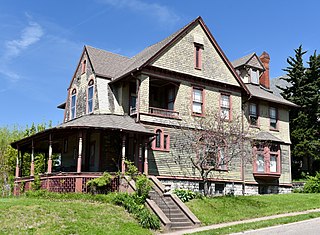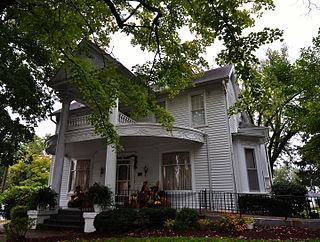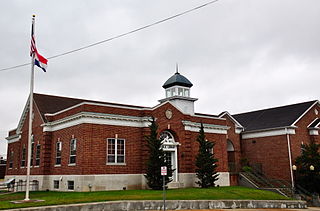
The Missouri State Capitol is the building that houses the legislative and executive branches of the government of the U.S. state of Missouri, as well as the Missouri General Assembly. Located in Jefferson City at 201 West Capitol Avenue, it is the third capitol in the city after the other two were demolished when they were damaged in fires. The domed building, designed by the New York City architectural firm of Tracy and Swartwout, was completed in 1917.

Poplar Bluff is a historic train station in Poplar Bluff, Missouri, United States, served by Amtrak, the national railroad passenger system.

Beaufort Historic District is a historic district in Beaufort, South Carolina. It was listed on the National Register of Historic Places in 1969, and was declared a National Historic Landmark in 1973.

The Nobility Hill Historic District is a residential historic district roughly bounded by Chestnut and Maple Streets and Cedar Avenue in Stoneham, Massachusetts. The district includes a number of high quality houses representing a cross section of fashionable housing built between 1860 and 1920. It was added to the National Register of Historic Places in 1990.

There are nine historic districts in Meridian, Mississippi. Each of these districts is listed on the National Register of Historic Places. One district, Meridian Downtown Historic District, is a combination of two older districts, Meridian Urban Center Historic District and Union Station Historic District. Many architectural styles are present in the districts, most from the late 19th century and early 20th century, including Queen Anne, Colonial Revival, Italianate, Art Deco, Late Victorian, and Bungalow.

The Fifth Street Bluff Historic District is a historic district located in Ottumwa, Iowa, United States. It was listed on the National Register of Historic Places in 1998.

Court Hill Historic District is a historic district located in Ottumwa, Iowa, United States. It is a residential area of large homes with a few small homes in between. The district was listed on the National Register of Historic Places in 1998 as a part of Ottumwa MPS.

The Upriver Residential District is a 145-acre (59 ha) historic district in Natchez, Mississippi that was listed on the U.S. National Register of Historic Places in 1983. It includes Colonial Revival, Late Victorian, Queen Anne, and other architecture, and has significance dating to 1790. It includes 389 contributing buildings. Its border was defined, on the south and west, by the borders of the already-NRHP-listed Natchez On-Top-of-the-Hill Historic District and the Downriver Residential Historic District.

The State Center Commercial Historic District is a nationally recognized historic district located in State Center, Iowa, United States. It was listed on the National Register of Historic Places in 2002. At the time of its nomination it contained 36 resources, which included 31 contributing buildings, two contributing structures, and three non-contributing buildings. The historic district covers the town's central business district. State Center is located at the highest point in Marshall County, midway between Marshalltown and Nevada. The town was established by the Cedar Rapids & Missouri Railroad on 80 acres (32 ha) of land in 1863. It was initially named "Centre Station," but William Barnes, the first railroad agent, changed the town's name to "State Centre."

Moore-Dalton House, also known as the Margaret Harwell Art Museum, is a historic home located at Poplar Bluff, Butler County, Missouri. It was originally built in 1883, and remodeled to its present form in 1896. It is a two-story, frame dwelling on a brick and stone foundation. It features a Classical Revival style semi-circular front portico with fluted Ionic columns and a second story balcony. The house was converted to an art museum by the city of Poplar Bluff in 1979.

Mark Twain School, also known as the Poplar Bluff Museum, is a historic school building located at Poplar Bluff, Butler County, Missouri. It was built in 1910, and is a two-story, "H"-plan, Classical Revival style brick building. The building consists of two, parallel, rectangular-plan, hipped roof blocks joined by an enclosed two-story flat roof corridor. It remained in use as an elementary school until 1988.

Poplar Bluff Public Library is a historic library building located at Poplar Bluff, Butler County, Missouri. It was built in 1936, and is a one-story, Colonial Revival style brick building. It sits on a full basement and has a gable roof.

Poplar Bluff Commercial Historic District is a national historic district located at Poplar Bluff, Butler County, Missouri. It encompasses 14 contributing commercial buildings in the central business district of Poplar Bluff. The district developed between about 1880 and 1930s, and includes representative examples of Italianate and Colonial Revival style architecture. Notable buildings include the Fraternal Building (1928) and Begley Building (1908).

North Main Street Historic District is a national historic district located at Poplar Bluff, Butler County, Missouri. It encompasses 19 contributing buildings and 1 contributing structure in a predominantly residential section of Poplar Bluff. The district developed between about 1880 and 1954, and includes representative examples of Queen Anne, Neo-Classical Revival, Colonial Revival, Late Gothic Revival, and Bungalow / American Craftsman style architecture. Located in the district is the separately listed Moore-Dalton House. Other notable buildings include the Holy Cross Episcopal Church and Zion Lutheran Church.

Cynthia–Kinzer Historic District is a national historic district located around Cynthia and Kinzer Streets, Poplar Bluff, Missouri. It encompasses 55 contributing buildings 1 contributing site, and 17 contributing structures in a predominantly residential section of Poplar Bluff. The district developed between about 1907 and 1961, and includes representative examples of Colonial Revival, Tudor Revival, Bungalow / American Craftsman, and International style architecture. Located in the district are the separately listed Alfred W. Greer House and J. Herbert Moore House. Other notable buildings include the Fred Anderson House, Hubert C. Roland House, Lyle Kutchback House, Lawrence and Alma Tedrick House, C.P. Schultz House, J. Truman and Lena Carter House, Carl Capps House, and James and Nelda McPheeters House.

The Willow–Bluff–3rd Street Historic District is a nationally recognized historic district located in Council Bluffs, Iowa, United States. It was listed on the National Register of Historic Places in 2005. At the time of its nomination the district consisted of 260 resources, including 162 contributing buildings, 56 contributing structures, 36 non-contributing buildings, and six non-contributing structures. The district is primarily a residential area that is adjacent to the central business district to the west. Part of the district is in Jackson's Addition, which is the first addition to the original town of Council Bluffs. It also sits along the base of the loess bluffs to the east.

South Main Street Historic District is a national historic district located at Fayette, Howard County, Missouri. The district encompasses 21 contributing buildings and 3 contributing structures in a predominantly residential section of Glasgow. It developed between about 1830 and 1935 and includes representative examples of Italianate and Queen Anne style architecture. Located in the district is the separately listed Edwin and Nora Payne Bedford House. Other notable buildings include the V. M Grigsby house, R. M. Moon house, Denneny sisters house, Joseph Shepard house / Joseph Davis house, Joseph Howard house, Thomas Howard house (1901), J. D. Tolson house, and the Robert Wilhoit house.

West Eleventh Street Historic District is a nationally recognized historic district located in Dubuque, Iowa, United States. It was listed on the National Register of Historic Places in 2004. At the time of its nomination it consisted of 288 resources, which included 191 contributing buildings, 32 contributing structures, 61 non-contributing buildings, two contributing sites, and one non-contributing structure. This district is a residential area on top of the bluff above the Jackson Park Historic District, which is in the river valley below. Its name comes from its historical association with the former West Eleventh Street Elevator, a funicular that was similar to the Fenelon Place Elevator to the south. For the most part the historic buildings here are single-family residences with their attendant out-buildings, although the number of out-buildings located here is relatively low. There is one apartment building and 46 duplexes. Some of the single-family houses were converted into multi-family residences, and then some of those were converted back. The various Victorian styles are found along the bluff fronts on the eastern and southern edge of the district, and vernacular structures on the northern and western sections. The Charles T. Hancock House (1890) was individually listed on the National Register. Given the steep bluffs in the district the historic structures are retaining walls and steps that replace the sidewalks.

(#96000701) Roughly bounded by Poplar, 6th, and Chesnut Sts. and K-7
























